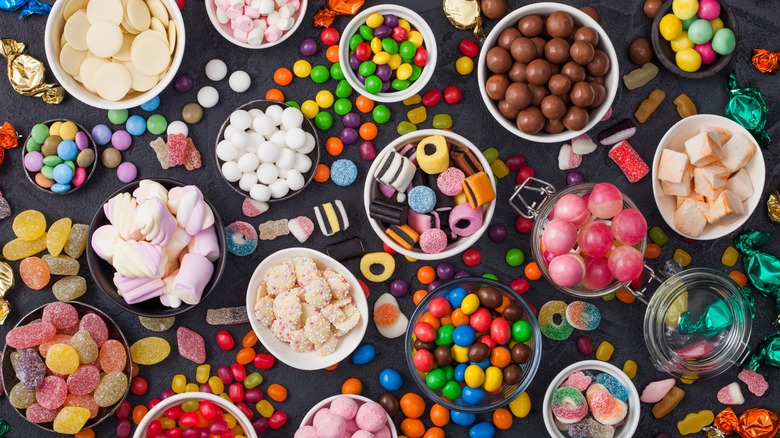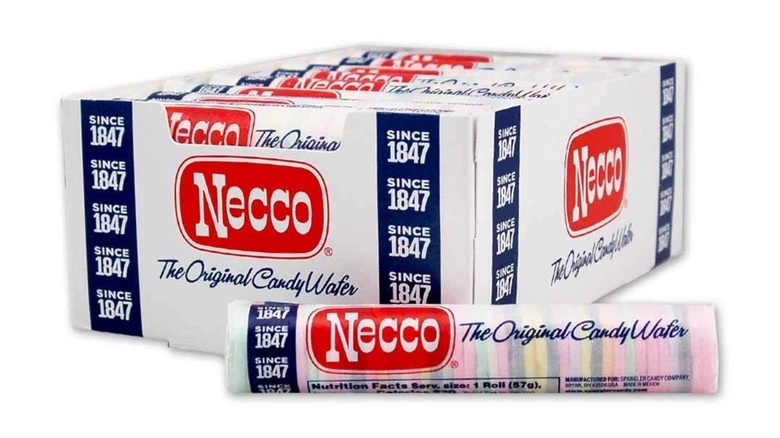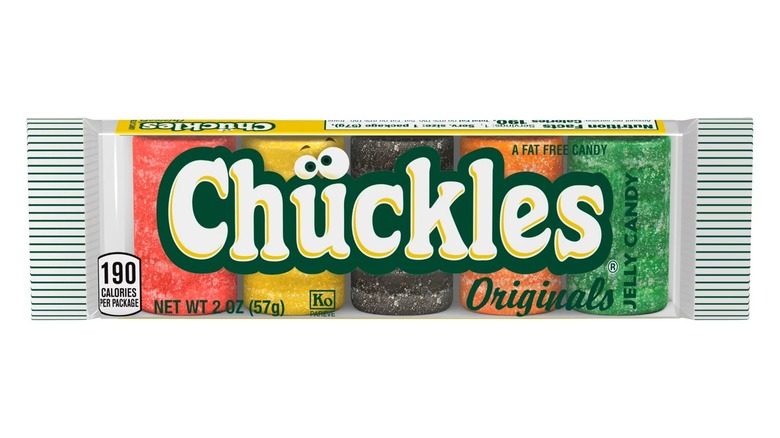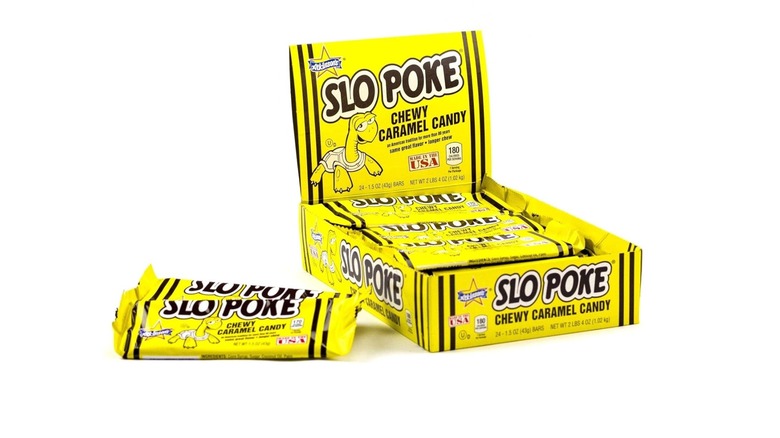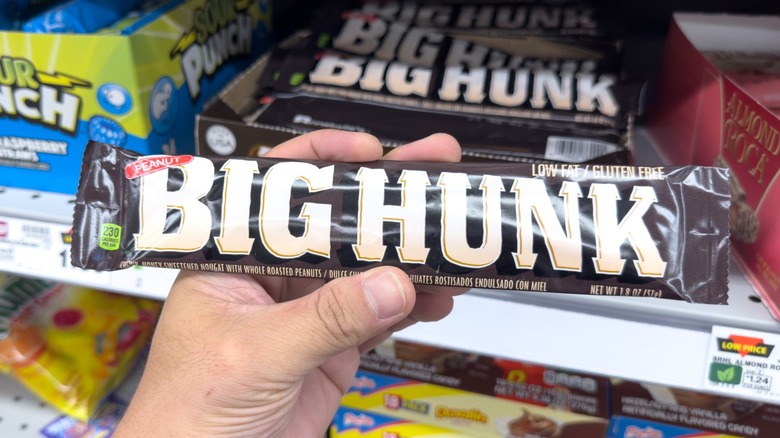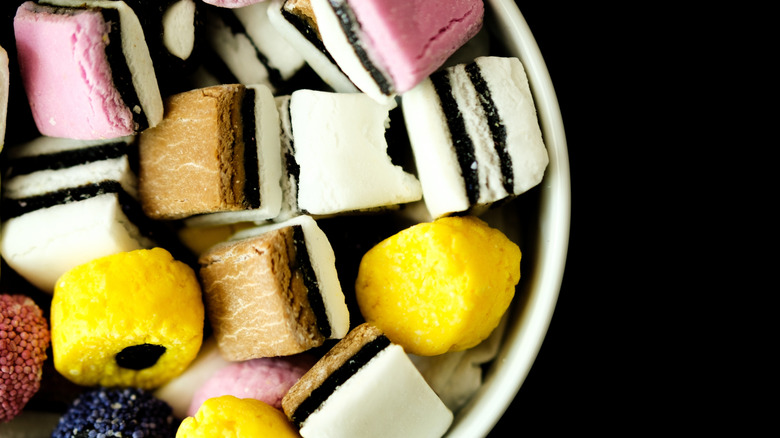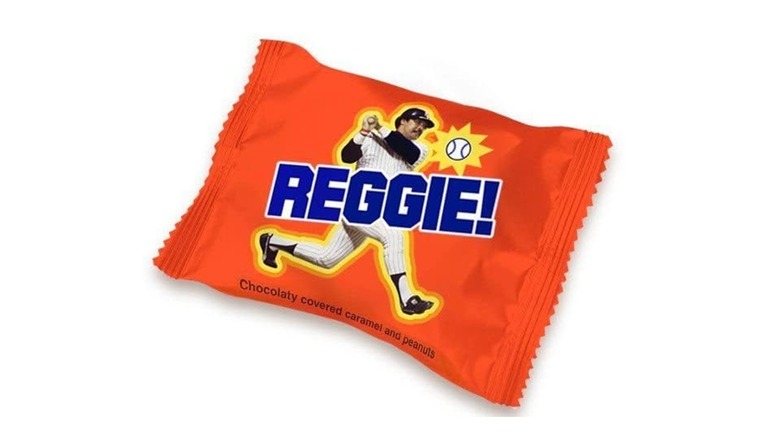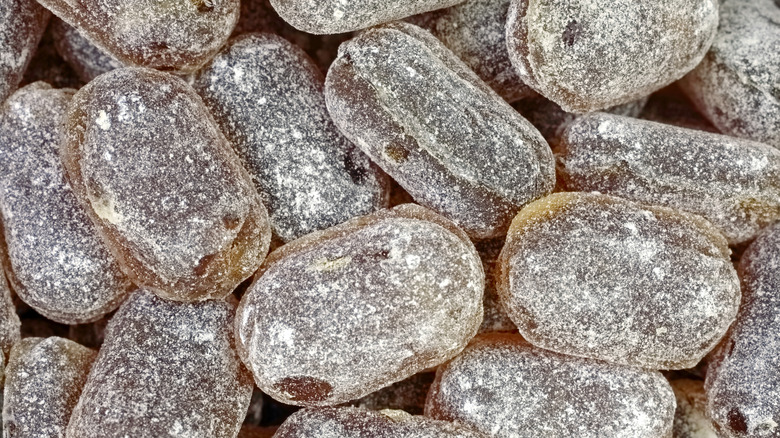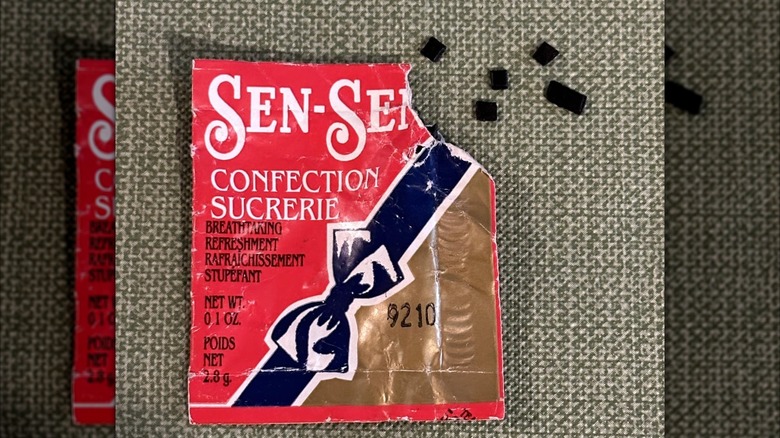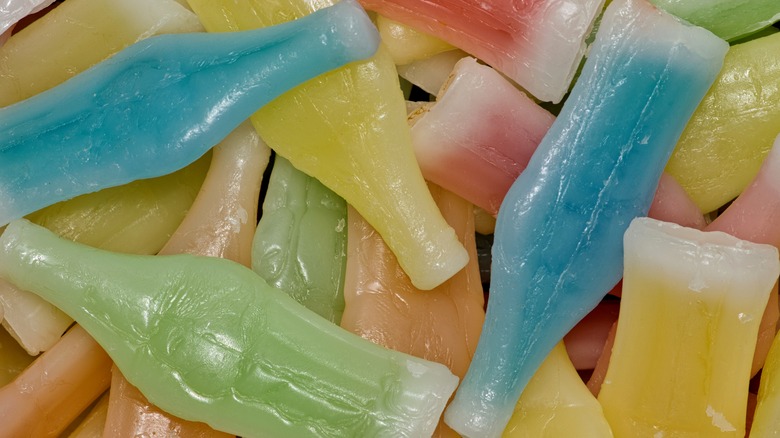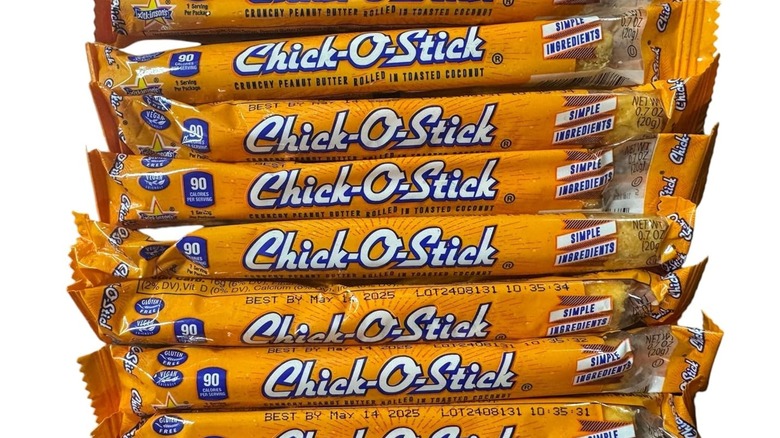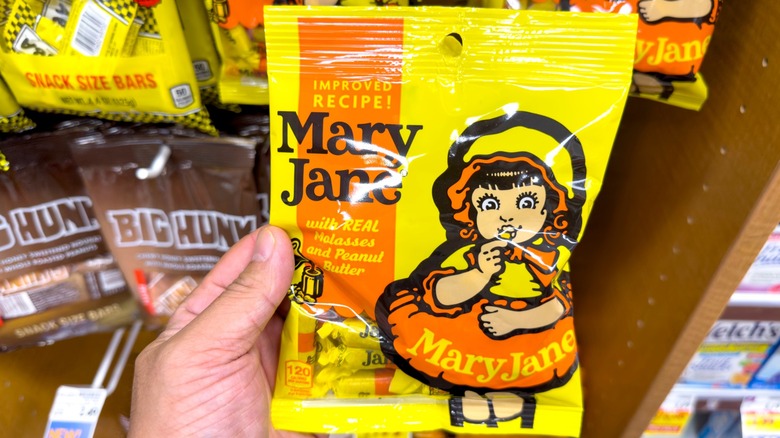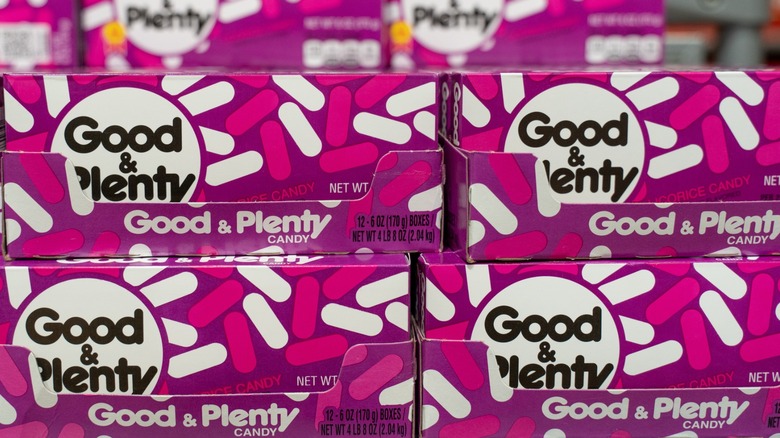Old-School Candies That Defined The Boomer Generation
We may receive a commission on purchases made from links.
Somewhere between the era of penny candy and the age of paying way too much for a Snickers, there was a period where boomers had their pick of the candy store. It was an age when new confections hit stores hard and fast, helped along by the advent of the television age and the power of the T.V. advertisement. You may see many of these retro goodies in the nostalgia section of candy stores across the U.S., and you can definitely find them online without trying too hard.
Many of these throwback treats became symbolic of the boomer experience. Now, they're vintage treats that conjure memories for the generation who loved them as kids, and who love introducing the tastes and textures to their children and grandchildren. The popularity and lingering aura of a simpler time gone by keeps manufacturers turning them out for the wide swath of older consumers eager to introduce their children and grandchildren to their favorite childhood flavors.
Whether it's a Mary Jane that morphed into the horrible Halloween peanut butter kiss or a package of Chuckles that gave gumdrops a cool upgrade, these retro candies are hallmark creations that helped define the Boomer Generation and its preference for supremely sweet treats.
Necco Wafers
Gen X-ers know Necco as the company that made chalky Sweetheart conversation hearts with the pink Pepto-Bismol mint flavor. But before contributing an unforgettable piece of holiday magic, the company produced Necco wafers, crispy coin-sized treats dusted with cornstarch and wrapped in parchment. It was a novel alternative to chewy or chocolatey candies, and it had a lasting impact that boomers still revel in to this day.
The wafers may have originated in 1847, as the label proudly states, but they became a standard confection for the candy-loving boomer. It was Oliver Chase, the creator of the wafer (originally called hub wafers), who invented a candy-cutting machine that made the crisp pieces possible. When Chase's company became part of the New England Confectionary Company — otherwise known as NECCO — the candy was redubbed Necco wafers.
For anyone who misses the conversation hearts, knowing Necco wafers are made from the same substance may create a love-hate relationship with the candy, as it has for some folks online. They still come in the same old-fashioned flavors, including banana, chocolate, licorice, and yes, Pepto-Bismol mint, as vibrantly pink as ever. If you want to impress the heck out of the boomers in your life, grab a pack of these throwback goodies and casually offer them a few. Just know you won't find them for nickel a roll.
Chuckles
If jelly slices were the early 20th-century equivalent of gummy candies, then Chuckles were the boomer equivalent of gummy bears. Their parents and grandparents may have kept dishes of gumdrops on the coffee table, but boomer kids had these fruit-shaped slices in their back pockets to share with their buddies.
Created by marshmallow maker (yes, that was a real job) Fred Amend, Chuckles first laughed their way onto the candy scene in 1921. As it does now, the original package contained sugar-crusted jellies featuring four flavors, plus licorice. Amend's great contribution to the world of confection was the sugar coating that kept the candies from sticking to one another, a problem that long troubled candy makers until then.
The factory where this hit candy was made bounced from owner to owner, until it became property of the Ferrara Candy Company, which continues to crank out Chuckles to this day. Boomer groups online continue to defend their favorite Chuckles flavors, while Gen X-ers recall their boomer parents, who worked in the factory, bringing home packages. Talk about a product with cross-generational appeal.
Slo Poke
If Dr. Frankenstein had been a candy maker instead of a mad scientist, he might have come up with something like the original Slo Poke Delicious Caramel. A cross between taffy, caramel, and a lollipop, this legendary boomer confection hit markets in 1926 as a penny candy. It lasted through the Great Depression to become a dime-store candy sold in bulk in the 1940s and 1950s, when boomer kids began spending their pocket money on the chewy, slow-burn confection.
Slo Poke wasn't the only caramel creation conjured up by the M.J. Holloway Candy Company; the manufacturer also came up with Milk Duds, the other chewy candy that holds on to your molars and doesn't let go. At least the original Slo Poke had a lollipop stick, so young boomers could avoid chewing on the gooey substance as much as possible. It was also a long-lasting candy that came with a wax paper wrapper for non-stick storage; M.J. Holloway had really thought things through. And if that sounds suspiciously similar to a Sugar Daddy, it's because they were essentially the same thing.
Slo Poke was scooped up in 1998 by Gilliam Candy and dropped off the radar, until Warrell Corporation bought the property and reconfigured the design. Slo Poke lost its stick and switched to bar form, as well as longer chews that look like stretched-out Tootsie rolls. Ultimately, Slo Poke landed at Atkinson's, where the boomer favorite lives on as one of the era-defining confections of the generation.
Big Hunk
Peel back the wrapper of a Big Hunk, and you'll understand how this nougat and peanut boomer candy classic became representative of a generation that did things differently to those who came before them, even when it came to candy. Instead of bothering with all that messy, delicious chocolate, Big Hunk deconstructs the classic candy bar and treats it more like a strip of taffy. It also differs with a honey-like flavor and a sprinkling of peanuts, to spruce up the texture.
When Big Hunk appeared in 1950, it challenged the idea that a candy bar needed chocolate to be popular. It was one of those magic concoctions that could be stretched out if chewed, or broken into pieces if dropped on the counter. This let boomers have their choice of experiences, which was especially important if they wanted to share their bar with others. Nobody wants a bite of a chawed-on candy bar, but a shard of a shattered Big Hunk? Absolutely.
As often happens when products cross generations, the Big Hunk formula used by Annabelle Candy today is worlds away from the Big Hunk recipe boomers remember. Those who've tried the modern version aren't impressed with the texture or flavor and long for the Big Hunk they remember. Apparently, it isn't filling-removing chewy anymore, taking on a fluffier consistency that doesn't live up to the boomer era classic.
Licorice Allsorts
If you happen upon a bowl of licorice allsorts, you could easily mistake them for novelty erasers or pieces from a puzzle that only super geniuses can solve. The blend of sharp licorice and smooth fruit creams is a perfect match for contrasting bright colors and black accents of these boomer favorites. They're as much a conversation starter as a candy snack, and an intriguing way for younger candy fans to discover the strange fascination of a classic boomer treat.
Allsorts were created by accident in 1899 by English salesman Charlie Thompson. While pitching licorice and a variety of cream paste candies to a client, Thompson spilled the boxes and merged the various candies. Rather than ruining things, the mash-up caught on like gangbusters and a regional candy combination was born.
It's pretty obvious that the flavor of black licorice comes from the licorice plant, which is distilled into an extract used in the candy. What's more enigmatic is how intriguingly the orange, vanilla, and coconut flavors of the cream layers complement the pungent licorice sections. It's a sophisticated flavor that boomers have had decades to get used to.
Reggie! Bar
It was 1978 when candy company Curtiss Candy Company decided that the baseball world needed the candy bar that truly celebrated a world-class slugger. Since the Baby Ruth candy bar was actually named after the daughter of President Grover Cleveland, Reggie Jackson was chosen as the honorary candy hero with the introduction of the Reggie! bar. Boomers with an affinity for baseball were over the backstop to grab this circular turtle-like patty of chocolate and caramel, with peanuts instead of pecans.
It not only changed the literal shape of the classic candy bar, it also put one of the most successful athletes in the history of the MLB even further in a league of his own. It was only on the market for three quick years before being taken off of shelves in 1981, joining the long list of discontinued chocolate candies. The reason behind its disappearance was likely a mix of business troubles for Curtiss and Jackson's pending retirement in the mid-1980s.
For boomers who long to relive the days when the Reggie! bar was a regular part of candy enjoyment, good news: This throwback candy is back in the game, called up to the majors for another round of crowd-pleasing action. This time, the hall-of-famer has a hand in the enterprise, coordinating with American Candy Nostalgia to recreate the boomer favorite that is The Reggie! Bar.
Horehound Candy
By the time boomers reached candy-eating age, horehound candy had been around for generations. This meant they more than likely encountered it as a treat offered by the older members of their family — a cruel trick for anyone who's ever believed they were getting a tasty bonbon only to end up with something more akin to a cough drop instead. The medicinal flavor acts like a lozenge and will do in a pinch, if there's no other sugar available in the house. In other words, it's an acquired taste that the Boomer generation may have had no choice but to get used to.
This may not be a bad thing for boomers looking to control their blood sugar. The truth behind the whole concept of this candy is that the herb used to flavor it, horehound, has been used to make medicinal syrups for millennia. More recent studies have suggested that this herb has the potential to lower glucose levels; an encouraging finding that warrants further investigation.
While it's no accident that these hard candies taste like cough syrup, boomers who learned to enjoy them years ago may have an advantage over younger generations who'd rather dig into something sweeter.
Sen-Sen
More of a breath mint than a traditional candy, Sen-Sen are tiny licorice-flavored crystals with such a concentrated taste they were known to burn sensitive tongues. The pieces in the packet were so small, it was easy to feel cheated when you tore one open. Maybe that was because it wasn't originally a candy, but something called "breath perfume," produced in the late 1800s by perfume manufacturer T.B. Dunn Company. It also wasn't marketed as a treat at the time, but as a cosmetic.
If you were a boomer when these flat little packets were popular, you probably carried them with you for moments when you needed a quick freshen up before chatting with others. If you have boomer parents, you more than likely discovered Sen-Sen when they regaled you with stories of how it was a date night essential before the smooching got started. The candy was so familiar as a grooming tool for boomer teens, it inspired Billy Joel to include it as a must-have on his evenings out in the lyrics of his nostalgic 1983 hit, "Keeping the Faith."
Sadly, Sen-Sen are one of those bygone candies that were discontinued due to lack of interest. Boomers have taken to the internet in search of a long-lost stash or a suitable substitute, though nothing seems to live up to the bold power of the original.
Nik-L-Nips
What boomer kid wouldn't love to chew off the top of a wax soda bottle and drain the juicy, sugary contents? Come to think of it, kids and all generations would relish the opportunity for such a strange and wonderful candy experience. A continuation of wax bottle candy from the early 1900s, Nik-L-Nips were a more enjoyable counterpart to wax lips and mustaches. This version actually had a sweet center to go with all the flavorless wax, though anyone who's had one knows how fun it is to chew on the bottle long after the juice is gone.
The name is a play on the word "nickel," the price of a single Nik-L-Nip when the candy was first released in the early 20th century. The "nip" came from the action required to open the bottle. Invented by a candy creator named Vinny Cavallo and marketed by W. & F. Manufacturing until sometime in the early 1980s, the candy is now a part of the Tootsie catalog. The name remains, with flavors given soda-friendly titles like Groovin' Green, Chillin' Cherry, O-So-Orange, and Hello Yello.
If you have a boomer in your life, you were likely introduced to Nik-L-Nips when they were sharing tales of the treats they loved when they were "your age." If not, maybe it's time to find a pack to see if they remember their moments with a non-candy candy that's still around.
Chick-O-Sticks
Chick-O-Stick is one of those odd vintage candies that looks like the candy factory forgot to add the chocolate coating. Think of this crunchy rod-shaped snack as the center of a Butterfinger; it's a flaky, peanut butter honeycomb core sprinkled with toasted coconut. It's a pretzel-like mash-up that merges sweet and salty with a crunch that few confections can compete with. It's also a childhood favorite of the boomer generation, especially members who favor a savory take on sweet treats — and who don't mind sweeping up crumbs after every bite.
Boomers have been crunching into these sticks since the 1950s, when Atkinson Candy Company fired up the conveyor belt and started churning out Chick-O-Stick in bulk. Back then, the candy was called Chicken Bones. When the company discovered another confectioner had trademarked the name, though, the shift was made to Chick-O-Stick.
In 2019, Atkinson updated the formula of Chick-O-Stick candy bars for a modern audience, reimagining the original without artificial flavors or colors. There's also a sugar-free version for the boomer who needs to keep their numbers in check. Now, you can find them in full-size sticks and bite-size bits, sold at stores throughout the U.S. The original bright-orange hue may be earthy brown now, but the taste is much the same.
Mary Jane
Mary Jane is likely a list topper for boomers who remember when this peanut butter and molasses taffy was something to look forward to. While it may have originally come in a red and yellow wrapper, by the time Gen X was hitting the late-October candy circuit, the gooey creation had snuck into twists of orange and black wax paper to become the treat bag treasures you saved for last: The dastardly peanut butter kiss. This may be why boomer parents happily grabbed those janky treats out of their Gen X kids' treat bags.
Mary Jane entered the candy conversation in 1914. Charles N. Miller, the Boston confectioner who created it, claimed to have borrowed the name from a beloved aunt, though folklore says he was trying to avoid being sued for snagging the name from a comic strip character. By the 1950s, the candy had inspired real-life Mary Jane models who stood in movie theater lobbies to promote the chewy treat.
Boomer or not, if you revisit the real Mary Jane as a grown-up, you might discover that it isn't as terrible as you remember. It's also much easier to chew when it's fresh, which could have saved folks a whole lot of dental trouble. Thanks to a recent re-release by Atkinson Candy, it's easy to find once again — no Mary Jane models required.
Good & Plenty
There's never been a candy that quite matched the glossy chicness of boomer-friendly Good & Plenty. These were the pinnacle of movie candy when a double feature still cost under a dollar, and a box of pink, white, and black candy-coated licorice bites went for a fraction of the cost of movie candy today. Philadelphia's Quaker City Confectionery Company first churned out the peppy pellets in 1893, though the candy's popularity gathered steam in the mid-1950s, thanks to a mascot named Choo-Choo Charlie. The animated engineer was featured in television ads that came with a catchy jingle, to help boomer kids annoy their parents.
Not only is this iconic box an original American invention, but it's also considered to be the oldest branded candy in the U.S. Having changed hands several times through the years, Good & Plenty landed with Hershey in the mid-1990s, where production of the candy pushed forward for a new generation of licorice fans to enjoy.
Holding a soft spot with boomers while carrying a taste of true American history in its shiny-shelled pieces, Good & Plenty is one of those old-timey comfort candies. It may not be the first pick you think of when gearing up for a trip to the multiplex, but it's highly likely your grandparents would grab a box in a heartbeat. Sure, they'd complain about the price, but they'd relish the opportunity to revisit a classic.
